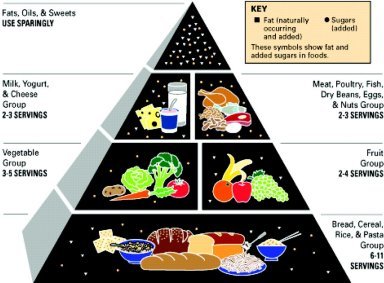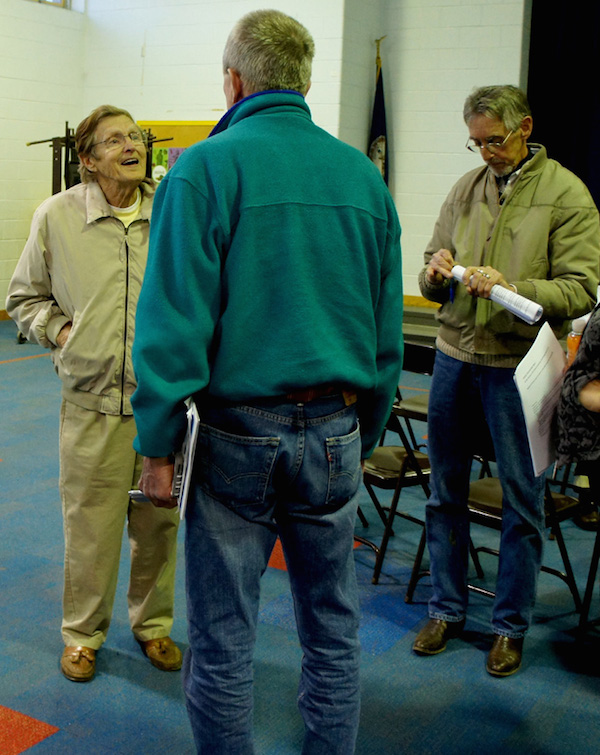An Afternoon Chat with Mayor Proto

George Proto is sworn in last July as Mayor of Cape Charles (Wave photo)
By WAYNE CREED
Cape Charles Wave
March 30, 2014
Mayor George Proto has begun holding “office hours” twice monthly for an hour at the Cape Charles Civic Center, and last week the Wave took that opportunity for an interview. Proto holds degrees from Drexel (BS Physics) and University of Virginia (PhD Materials Science). He worked at IBM for 30 years, interacting with and managing diverse groups of people from multiple countries and continents.
“I was responsible for projects that demanded that people worked together in order to be successful.”
So, how did you come to find yourself in Cape Charles?
Well, my wife tells the story better than I can — but, briefly, I guess I would go back to 1999, and both our parents had just passed away, within a few months of each other. And we just wanted to get away, so went to Bethany Beach. We just wanted to sit in the sun, and just relax, maybe jump in the surf now and then. But it rained the entire time. The whole week.
Now my wife, who is from Milford, Delaware, still had a good friend living in Belle Haven, and since the weather was going to be so bad anyway, we drove down to the Eastern Shore to visit, and explore some. There were small towns all up and down, and I even got to see the Bridge-Tunnel for the first time (I had never been that far south on the Peninsula before).
On the way down to see the CBBT, we saw the sign for Cape Charles, so on the way back we pulled in and explored, and just fell in love with the place. We bought property, and when we retired, we moved here.
How would you rate the current status of Cape Charles?
Overall, I would say it’s in good shape. Of course, there’s much more to do. Obviously, from an economic standpoint, I would like to see more growth. The tourism — the current tourism we have I think is a good thing, but I would like to see more growth in industries that are year round. I think the yacht center is something we can look to, where the success there will create, or provide opportunities for other businesses to build up around it.
One asset that we do have in our favor is high speed Internet — did I ever tell you what I did when I worked for IBM? Well, basically whatever they told me to do (laughs) — but later on, I was working more in project management, or more problem management, where our teams were spread out all over the world. I think high speed Internet can allow that kind of collaborative work to occur here.
What we’d like to see is a little more density [year round], to help all of our businesses — but there are barriers to getting people to move here. Number one is the schools. Then there is the lack of emergency medical services. Third is the toll. Now, if we could lower the toll even more, I’m sure there are people in Virginia Beach that would move here, if we could also offer a better public school option. Like I said, I think our tourism is always going to be a big part of what we do, but in our case, it is the type of tourist that chooses to come here that differentiates us. They seem so willing to embrace us, to embrace our values. [Read more…]
County Planning Commission Hears Discouraging Data
By WAYNE CREED
Cape Charles Wave
March 30, 2015
The Northampton County Planning Commission met March 25 to continue amending the zoning and land use map. Commissioners Mike Ward provided statistical handouts including the following:
· Population decreased 7.39% in the years 2000-2014;
· Jobs declined 20.7% in the period 1999-2014;
· Property values declined 20.26% between 2009-14;
· Median Household income declined 7.44% between 2010-2014;
· Poverty rate increased to 24.3% in 2013, up 6.3% from 2007; and
· Economic Development plummeted in recent years.
· Northampton commercial establishments that closed in recent years include Roses, LeCato, A&N Clothing, Bank of America in Cape Charles, Sun Trust Bank in Nassawadox, KFC, Taco Bell, Wendy’s, and Burger King and Fresh Pride in Exmore. Rural Health moved from Nasswadox to Onancock, and Riverside Shore Memorial Hospital is doing the same.
Ward also noted that Shore Memorial Hospital’s impending move will create health, safety, and public welfare challenges. Similar challenges also face economic development endeavors, and poor school performance and low teacher salaries serve as a disincentive to attract “quality personnel.”
Residents may want to prepare for an increase in taxes, he said, as there will be fiscal pressures due to the need in part to “replace aging equipment and maintain existing facilities, together with salaries”.
When the Planning Commission meets April 7, on the agenda are three Special Use Permits, a single wide mobile home request, a Conference Retreat Center for Mimosa Farms, and a proposal to open a raw bar/bistro in the 1,000 square-foot Harvey building on the waterfront in Oyster. [Read more…]
COMMENTARY
Chicken Litter Incinerator Causes Toxic Waste
By KAREN DAVIS
United Poultry Concerns
March 30, 2015
In the Cape Charles Wave on March 22, Ken Dufty commented on WAYNE CREED Pays a Visit to United Poultry Concerns regarding a proposal to build a chicken litter incinerator in Northampton County “aimed at giving the industrial chicken farms a purported solution for the millions of pounds of chicken manure generated annually” on the Eastern Shore. In Maryland alone, the chicken industry produces 700 million pounds of poultry litter each year, of which 300,384 tons exceed the capacity of local cropland to assimilate the phosphorous and other components of the waste, according to a study cited by Food & Water Watch in their May 2012 report, Poultry Litter Incineration: An Unsustainable Solution.
“Poultry litter” is the mixture of fecal droppings, antibiotic residues, heavy metals, cysts, larvae, dead birds, rodents, and sawdust in which the chickens are forced to sit for six weeks before they are slaughtered. According to the Chesapeake Bay Foundation, used poultry litter has four times the nitrogen and 24 times the phosphorous found in pig and dairy cow operations. Dumped on the environment, this mountain of toxic waste burns fragile plant cells, poisons the water, and spawns excess algae that consume aquatic nutrients. The excess algae block sunlight needed by underwater grasses and suffocate fish in the process of decay.
Used poultry litter — which is nine parts manure by the time it is scraped out of the chicken houses after several years of accumulation — has been found to be “rich in genes called integrons that promote the spread and persistence of clusters of varied antibiotic-resistant genes,” according to a May 2004 article in Farm and Dairy.
The Food & Water Watch report on poultry litter incineration cites studies showing that burning poultry litter for electricity on the Delmarva Peninsula would almost certainly depend on taxpayer subsidies. An analysis by the North Carolina Department of Environment and Natural Resources suggests that burning poultry litter “may actually produce as much or more toxic air emissions than coal plants.” The emitted poultry litter toxins are carbon monoxide, carbon dioxide, nitrogen oxides, sulfur dioxide, sulfuric acid, hydrochloric acid, volatile organic compounds, dioxin, particulate matter, and arsenic. [Read more…]
WAYNE CREED: I Was Wrong about Backyard Chickens
By WAYNE CREED
Cape Charles Wave Columnist
March 30, 2015
On Friday, March 20, Farm Animal Rights Movement (FARM) set up their annual campaign, the 2015 MeatOut, meant to encourage the public to try a vegan diet for one day. People from 96 countries pledged to “Eat Vegan for a Day.” This simple effort saved 1,343 farmed animals. MeatOut was soon followed by an opinion in the New York Times by Dean Ornish, clinical professor of medicine at the University of California, San Francisco, and the founder of the Preventive Medicine Research Institute. Ornish’s article focused on the questionable notion that “Americans have grown fat because they eat too much starch and sugar, and not enough meat, fat and eggs.”
The implication is that consuming lean meat and animal byproducts (even those labeled organic or grass fed) is somehow “healthy.” More recent research indicates that animal protein may significantly increase the risk of premature mortality from all causes, among them cardiovascular disease, cancer, and Type 2 diabetes, and a study published by NIH last March found a 75 percent increase in premature deaths from all causes, and a 400 percent increase in deaths from cancer and Type 2 diabetes, among heavy consumers of animal protein under the age of 65 — those who got 20 percent or more of their calories from animal protein.
According to Ornish, “Low-carb, high-animal-protein diets promote heart disease via mechanisms other than just their effects on cholesterol levels. Arterial blockages may be caused by animal-protein-induced elevations in free fatty acids and insulin levels and decreased production of endothelial progenitor cells (which help keep arteries clean). Egg yolks and red meat appear to significantly increase the risk of coronary heart disease and cancer due to increased production of trimethylamine N-oxide, or TMAO, a metabolite of meat and egg yolks linked to the clogging of arteries.”
When questioning the ethics of eating and the effect that our food choices can make, it is important to realize that those choices have much broader implications than just weight loss or personal health and well-being — they also play a big role in the health of our environment. By the numbers, one person going vegan for one year would preserve 53,900 square feet of rain forest, and save 1,350,500 gallons of water.
For many folks living on the Eastern Shore or greater Delmarva, the environmental effects of agribusiness have been a concern for some time. A report from the Food and Agriculture Organization of the United Nations (FAO) provides key data points on the adverse environmental aspects of animal farming, such as land degradation, air and water pollution, and loss of biodiversity. Even as agribusiness (livestock) only accounts for a relatively small proportion of the total GDP, it should still be noted that the sector still plays an important role both socially and politically in not just the poorest developing countries, but also the poorest communities of the United States. [Read more…]
ALTERNATIVE TABLE: Fat and Scientific Shenanigans
By KAREN GAY
Cape Charles Wave Columnist
March 30, 2015
In my article of last week, I featured the Weston A. Price Foundation (WAPF) and described how their recommended traditional diet helped me lose 50 pounds over nine months by changing my fat intake to greater than 30 percent of calories coming mostly from saturated and monosaturated fats.
 As I lost my food cravings I began to do research on fat and its impact on one’s body. How could it be that for over 40 years the U.S. Department of Agriculture (USDA) was a strong proponent of low fat diets?
As I lost my food cravings I began to do research on fat and its impact on one’s body. How could it be that for over 40 years the U.S. Department of Agriculture (USDA) was a strong proponent of low fat diets?
In 1968, after seeing an image of a child who had died of starvation in the CBS documentary, Hunger in America, George McGovern became the chair of the “Select Committee on Nutrition and Human Needs” with the goal of wiping out hunger and malnutrition in the United States. In 1977 the Select Committee published the “Dietary Goals for the United States” after hearing Dr. Ancel Keys and other supporting researchers speak about the link between saturated fat and cholesterol consumption.
From 1972 to 1973 and concurrent with the Select Committee, the American Heart Association, American Medical Association, and the National Academy of Science developed the following recommendations:
- Americans’ cholesterol is too high;
- We should measure our cholesterol in medical examinations;
- People considered as “at risk” should receive appropriate dietary advice;
- At risk Americans should reduce their intake of saturated fat by substituting polyunsaturated vegetable oils;
- Modified and ordinary foods (to support the ingestion of vegetable oils) should be available in the marketplace; and
- More studies should be performed to determine if lowering cholesterol can reduce chronic heart disease.
 The piling on the bandwagon by these organizations led to the 1992 USDA Food Pyramid that most of us remember so well.
The piling on the bandwagon by these organizations led to the 1992 USDA Food Pyramid that most of us remember so well.
So how did all of these organizations arrive at these conclusions? I believe it was the work of Ancel Keys in the 1950s that started the idea that saturated fat led to the increase in heart disease. He noticed that death from heart disease dropped in areas where food rationing had been in place due to WWII and increased in industrialized areas of the world. Keys created graphs using food intake data and mortality statistics from the late 1940s using six countries: Japan, Italy, England, Australia, Canada, and the USA. The data appeared to show a correlation between the ingestion of fat and the increase in heart disease. We now call this the Diet-Heart Hypothesis which puts forward the idea that saturated fat causes cardiovascular disease (CVD) by raising blood cholesterol. He presented a graph at the 1955 World Health Organization conference that mapped fat intake to each country’s rate of death from heart disease. [Read more…]
Council Appoints Brent Manuel Town Manager, Commends Heroes for Icy Rescue
By WAYNE CREED
Cape Charles Wave
March 23, 2015
Cape Charles Town Council met March 19 at the Civic Center, and Mayor George Proto began by announcing that the Town has appointed Brent T. Manuel of Woodstock, Virginia, as the new Town Manager. The appointment is effective April 6.
Hardly a newcomer to local government, Manuel has over 16 years of experience, having served the towns of Purcellville, Strasburg, and Woodstock and the county of Frederick. For the past 13 years Manuel was Woodstock’s Assistant Town Manager of Operations and Director of the Department of Planning and Community Development.
“While I have thoroughly enjoyed my time in the Northern Shenandoah Valley, I am very enthusiastic about the opportunity that awaits in the beautiful town of Cape Charles,” Manuel says.
Mayor Proto stated, “The Town Council and I look forward to his beginning, his tenure, and the contributions I believe he will make to the town.”
Councilman Frank Wendell added, “We are very excited to have him here, and the fact that he chose to live in town is a very good sign.”
Although the decision to hire Manuel was made a few weeks ago, the process had been stalled due to his difficulty finding rental housing within the town limits. But with that problem resolved, Manuel begins work in two weeks.
Mayor Proto issued Commendations to Officer Tom Potts, Sergeant Jay Bell, and Keith Lewis for a dramatic rescue at the Town Harbor on the night of March 5. About 7:45 p.m., Lewis saw a man fall off the icy dock into the frigid water. He immediately dialed 911, alerted authorities, and attempted to assist the victim. Officer Tom Potts soon arrived, and he and Lewis crawled out on the ice, where Potts worked to keep the man above water. A few moments later, Sergeant Jay Bell arrived and joined the effort. The team pulled the victim out of the water and dragged him across the ice and up to the dock where an ambulance was waiting to transport him to the hospital. The victim has made a full recovery. [Read more…]
Rezoning ‘Information Session’ Turns into Showdown

Supervisor Larry Trala faces up to two of Northampton County’s most determined rezoning opponents: Bob Meyers (from back) and Ken Dufty (right). (Wave photo)
By WAYNE CREED
Cape Charles Wave
March 23, 2015
After several delays, the winter weather finally relented and allowed Northampton County to conduct two Public Information Sessions for the county’s proposed zoning ordinance. Although the event was sparsely populated, those in attendance were eager to hear or see just what was in store, and if it differed in any way from what had already been gleaned from Economic Developer Charles McSwain’s Information Paper.
The first session, at Kiptopeke Elementary, kicked off with an overview of what the county considered the most significant and impactful changes, such as shore widths, allowable uses, the continued incorporation of the Bay Act throughout the county, and the inclusion of mobile homes in the plan. County Long Range Planner Peter Stith emphasized that this effort was meant to be a way to streamline the process, make definitions more clear, and simplify the overall zoning, such as by reducing the number of districts from 21 to 15.
The room had stations set up on the perimeters, with county staff available to answer questions. Mr. Stith and the Geographic Information System Department also provided several large wall maps showing just what the physical changes are going to look like in a very holistic manner. Each station was loaded with a fairly robust level of information, and county staff was pleasant and eager to answer questions. Among those attending were Cape Charles Town Council members Chris Bannon and Joan Natali.
While the mood of the general public was initially buoyant, news that public comments would be limited to “written only” comments sucked a good bit of the air out of the event. As the public milled about, and somewhat hushed conversations echoed off the cinder block walls of the auditorium, the room began to take on the sad feel of a job fair intended for recently released inmates from the county jail rather than an exciting question and answer session.
Night two at Occohonock Elementary, however, had an entirely different feel. The format was the same, but after Planner Stith finished his introduction and was on his way to one of the tables, he was bushwhacked by Dr. Art Schwarzschild of Willis Wharf. “Peter, I have a question. There is such a big difference between the first proposal and the current one, and the difference is not well highlighted. We at Willis Wharf and Oyster, we spent a lot of time, two years, picking all the things we wanted in our villages — why did we change this for something new that was developed behind closed doors?” he asked. [Read more…]
LETTER: Supervisors’ Complacence Threatens County
March 23, 2015
DEAR EDITOR,
My wife and I attended the zoning informational meeting at Kiptopeke School this week. While discussing the zoning with one of the Supervisors present we were told that he believes the majority of people in the county actually support the proposed zoning but are simply not attending the meetings, and that the group of people who attend all the meetings (and overwhelmingly oppose the zoning) are actually the minority. The takeaway here would seem that if you are against the zoning changes, or at least skeptical of them, you had better get to the meetings and be heard or you are assumed to be supporting them.
While expressing our concerns to this same Supervisor about the zoning changes paving the way for uses such as medical waste disposal and manure processing/incineration (just to name a couple) we were told,”Uses like that would never happen.” But if our zoning is weak and leaves loopholes, then, whether we like it or not, uses like these can and will happen and could negatively affect every resident of Northampton County.
Any use, in any district, that has the potential to
— foul and pollute our air,
— pollute the water we drink or grow our clams and oysters in,
— pollute the ground our crops are grown on and our children play on, and
— negatively impact the values of our business and homes,
should NEVER be allowed “by right.” These types of uses should always have to go through a “special use” process so that community members have the ability to change or stop, when necessary, something that is harmful to the county as a whole.
RICH GLIEDMAN
Cape Charles
Letters to the Editor are welcome, and a diversity of opinions is encouraged. Send submissions to [email protected].
THE ALTERNATIVE TABLE: How I Lost 50 Pounds
By KAREN GAY
Cape Charles Wave Columnist
This is the first of a series of columns I am calling The Alternative Table. I will discuss many topics beginning with interviews and photos of some of the new sustainable farms on the Eastern Shore and also covering what are healthy food choices and cooking techniques, recipes, important books and movies on these subjects, and alternative health options. I’ll approach these subjects from the point of view of a journalist, reporting on farms I’ve visited and topics I’ve been reading about. I’d like to be clear about the fact that I am a layperson with wide-ranging interests in these topics and not a doctor, nutritionist, or healer.
My first topic is the Weston A. Price Foundation and how it has helped my health. I understand that what has worked for me is not necessarily a weight loss solution for everyone. We all come from different genetics, cultural heritages, and physical experiences, and as a result each of our bodies operates in a slightly different manner.
At first, my friends looked at me incredulously when I explained how I lost 50 pounds by incorporating the principles of the Weston A. Price Foundation. The ingredient that did it for me was fat — lots of fat! Like most people coming of age in the 1970s I learned about the new USDA food pyramid and the need to eat less meat, dairy, and fat. I took this seriously, as my mother had always kept abreast of health trends, listening to Carlton Fredericks and Adele Davis on the radio. My siblings and I were probably the only children who went to school after a breakfast of orange juice and brewer’s yeast. Fortunately, the niacin flush wore off just as I arrived at school.
Fast forward past high school, college, marriage, kids, and a career. By the time I retired in April 2014 I was physically exhausted from raising children, coping with a really stressful career spent mostly in front of computers in dark rooms, and a commute that took occasionally more than two hours on the return trip. I was way overweight, exhausted, and my preference during non-work days was to read in bed. Somehow over the years when initially I tried to make healthy food choices I stopped reading labels and bought food primarily for convenience. I found myself looking forward to meals and snacks as replacements for fun and over time began to crave sugar and then fat alternately.
Once I got those cravings, it got to be an addiction. My drugs of choice were potato chips followed by ice cream. No matter how each day I resolved to skip the grocery store, by the time I finished work I could not resist. At the time I knew I had a problem but did not know how to resolve it. For quite a few years I was convinced that I just lacked willpower. [Read more…]
Supervisors Nix Kiptopeke Villas Restaurant Permit
By WAYNE CREED
Cape Charles Wave
March 16, 2015
On a very warm evening with a hint of spring showers in the air, the Northampton County Board of Supervisors met for the March 10 regular meeting. The Kiptopeke Villas project once again made an appearance, this time seeking a second Special Use Permit to construct and operate a 12 table takeout restaurant on county parcel 69. The 2,500 square-foot “greasy spoon”-style eatery would consist of 12 tables and an outside porch area. There would be no drive-thru capability.
During public comments, Charles Bruckner questioned whether the developer had done due diligence in regard to groundwater and aquifer protections, in light of the fact that the site once housed a gas station, and the tanks are presumably still underground. “Do you have any engineering data you can point to? Have you even done a phase one or two environmental impact assessment? My worry is that there was a gas station there. The DEQ may have looked at it, but they are not an investigative agency. They come in after something has happened to help remediate,” Bruckner said.
Terry Ramsey followed with comments about the parking, especially by larger vehicles such as RVs and truck or boat trailers. “This should be safety first. This will change the fundamental character of our neighborhood. It is not an appropriate use” for this area,” he said. Ramsey also urged Supervisors to limit or even ban music played outside and consumption of alcohol on the porch.
Supervisor Granville Hogg voiced concerns about the project to County Planner Peter Stith: “I have concerns with page 3 where it says it will not adversely affect the health of the area. This is zoned Hamlet, I understand that, but do you feel this is an appropriate use?” Hogg asked.
“Are you suggesting it should be zoned residential?” responded Stith. “I don’t know what development [for this area] holds for the future.”
Hogg continued: “Is this mass drain field really appropriate for this area? When we first started this, we were told it was going to be low impact; now it seems to be fairly substantial.” [Read more…]
WAYNE CREED
County Should Stop Yanking Town’s Chain
By WAYNE CREED
Cape Charles Wave Columnist
March 16, 2015
On January 27, the Town of Cape Charles sent correspondence to County Administrator Katie Nunez voicing displeasure with the Board of Supervisors’ reluctance to bow to the Town’s whims — that is, drop everything it was doing and pick up work on the Cape Charles request to have the County include a Town Entrance Overlay District in proposed zoning changes.
The written response from the County was a bit like a horse swatting away an annoying fly with its tail — a nice way of telling Cape Charles to go pack sand.
While it is true that few citizens of Cape Charles actually take the Mayor, Town Council, or Planning Commission seriously, it is worrisome that this same sentiment has also seeped out into the county.
This sentiment may be marginally understandable, given the petulant and peevish tone of the town; however, the county still has some explaining to do, mainly as to why they have been reluctant to take up the matter in the first place. In the correspondence to Nunez, the town noted that in a previous letter, the Board of Supervisors was unable to deal with the town’s request: “Your letter of June 11, 2014 indicated that the Board of Supervisors was unable to consider our request for the inclusion of the Historic Town Overlay Corridor in the proposed zoning amendments due to current workload . . . .”
Workload? What workload? The county makes it sound like they toil away in a Kentucky coal mine. It seems the county is always able to make time for so many inane and inconsequential endeavors; their response to the town on this very important matter appears to be nothing short of a blow-off.
Mayor George Proto’s statement is a legitimate response. Rather than being treated like a creepy, stalker boyfriend who refuses to take no for an answer, the town at least deserves a straight answer. Proto wrote, “I am aware that the BoS has been diligently working through potential revisions [to the proposed zoning] . . . we would like the BoS to consider our request . . . before completing this review [of proposed zoning changes].” Even as diplomatically as they tried to wordsmith it, the town’s frustration is becoming more apparent. [Read more…]



















